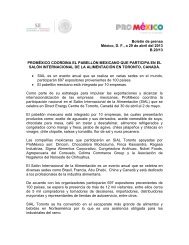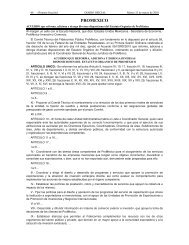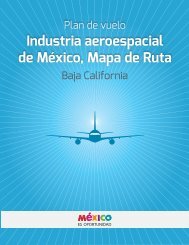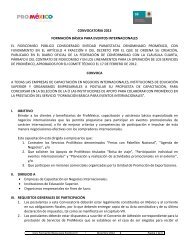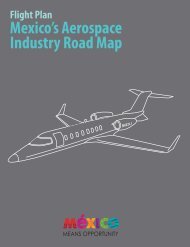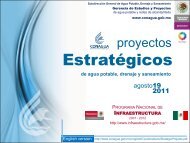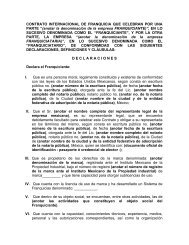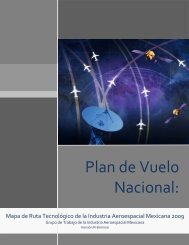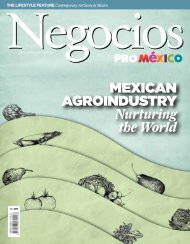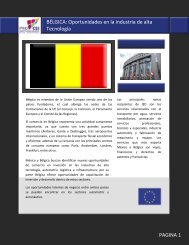AUTOMOTIVE IndUsTrY In MExIcO Ready to Overtake - ProMéxico
AUTOMOTIVE IndUsTrY In MExIcO Ready to Overtake - ProMéxico
AUTOMOTIVE IndUsTrY In MExIcO Ready to Overtake - ProMéxico
Create successful ePaper yourself
Turn your PDF publications into a flip-book with our unique Google optimized e-Paper software.
24 Negocios <strong>ProMéxico</strong> Negocios <strong>ProMéxico</strong> 25<br />
produce up <strong>to</strong> 175,000 vehicles a year, beginning in 2013. Meanwhile,<br />
Fiat-Chrysler bolstered its plant in Estado de México, the<br />
only one in North America that manufactures the Fiat 500 and the<br />
Dodge Journey.<br />
One of the most recent investment announcements was Volkswagen<br />
AG, which announced the construction of its first Audi<br />
plant in Mexico, with an investment of nearly two billion usd<br />
<strong>to</strong> produce the Q5 SUV, beginning in 2016, <strong>to</strong> service the North<br />
American market.<br />
Within the framework of the constant competition between<br />
countries <strong>to</strong> attract international investment, the company performed<br />
a comparison between Mexico, Brazil, China and <strong>In</strong>dia,<br />
using the Foreign Direct <strong>In</strong>vestment (FDI) Benchmark <strong>to</strong>ol, which<br />
was based on investment costs for a vehicle assembly plant. Using<br />
the index of attractiveness for FDI, two variables were compared<br />
between the countries: quality in the industry’s development and<br />
installation costs for a plant.<br />
According <strong>to</strong> the results, Brazil has a high quality level in the<br />
development of the industry, but also reports high costs for the<br />
establishment of an assembly plant. <strong>In</strong>dia and Mexico offer a more<br />
favorable balance between quality and costs for a fac<strong>to</strong>ry. However,<br />
the Mexican case stands out for having export destinations <strong>to</strong><br />
markets with high international quality standards such as the US<br />
and the European Union.<br />
three Keys for success<br />
Several fac<strong>to</strong>rs account for the success of the au<strong>to</strong>motive industry<br />
in Mexico, yet Eduardo Solís sums them up in<strong>to</strong> three: a<br />
privileged location, access <strong>to</strong> markets through a network of free<br />
trade agreements (FTAs) and the experience of the entrepreneurs<br />
and workforce.<br />
“The country’s geographical location allows it <strong>to</strong> be a genuine<br />
platform for export, mainly for American markets. We are exporting<br />
<strong>to</strong> more than 100 countries and have managed <strong>to</strong> diversify our<br />
exports. Before, we exported 80% of our production <strong>to</strong> the US and<br />
now, it is between 60% and 63%. Latin America has become our<br />
most dynamic region for exports,” states Solís.<br />
“Recently we have established full openness with Colombia,<br />
Uruguay and Chile [...] Not <strong>to</strong> mention the Mercosur trade area,<br />
which has allowed us <strong>to</strong> successfully export <strong>to</strong> Argentina and<br />
Brazil [...] Mexico’s network of FTAs also allows us <strong>to</strong> reach the<br />
European Union and Japan [...] this network is a pillar for Mexico<br />
<strong>to</strong> attract investments,” he explains.<br />
According <strong>to</strong> Solís, “the experience that we have in the au<strong>to</strong>motive<br />
industry is composed of three fac<strong>to</strong>rs. First: world-class labor,<br />
with expertise in activities such as metalworking and casting,<br />
which allows Mexico <strong>to</strong> climb the value chain and attract more<br />
projects with added value. The second fac<strong>to</strong>r is the network of<br />
suppliers within the country that has made Mexico the major au<strong>to</strong>motive<br />
supplier <strong>to</strong> the US,” he continues. The third fac<strong>to</strong>r, as far<br />
as experience is concerned, “is our proven productivity in manufacturing<br />
vehicles and au<strong>to</strong> parts [...] Mexico is one of the leaders<br />
in productivity; an example is the Nissan plant in Aguascalientes<br />
which, according <strong>to</strong> officials of the brand themselves, is number<br />
one in the world in terms of productivity, and the same goes for<br />
the Ford plant in Hermosillo [...] all the plants operating in the<br />
country say that they have the highest standards of productivity in<br />
Mexico,” he concludes.<br />
pho<strong>to</strong> courtesy oF nissAn<br />
the au<strong>to</strong>Motive industry in<br />
Mexico travels at high speed<br />
<strong>to</strong>ward the dynaMisM driven<br />
by the investMents Made in the<br />
country. proMéxico data indicates<br />
that between 2007 and 2012, the<br />
investMents Made by asseMblers<br />
<strong>to</strong>taled 10.78 billion usd, and that<br />
the Major capital injections were<br />
Made by nissan, general Mo<strong>to</strong>rs,<br />
volkswagen, ford, honda, fiat,<br />
Mazda and daiMler trucks.<br />
au<strong>to</strong> parts: “in their prime”<br />
Driving down the other lane of the highway is the au<strong>to</strong> parts industry,<br />
which is experiencing one of the best moments of the last<br />
10 years in Mexico. “We ended 2011 with record turnover figures,<br />
with 67 billion usd of production, of which 45 billion was for export,<br />
mainly <strong>to</strong> the US market. It’s our highest figure ever and that<br />
is taking in<strong>to</strong> account that we are recovering from the crash of<br />
2008 and 2009,” says Oscar Albín, president of the National Au<strong>to</strong><br />
Parts <strong>In</strong>dustry (INA).<br />
Albín believes that the industry’s dynamism is rooted in the<br />
“au<strong>to</strong>motive recovery that the US market experienced in 2011 and<br />
in 2012,” because people who could not change their vehicles during<br />
the 2008-2009 crisis began <strong>to</strong> renovate them in 2011. He added<br />
that Mexico is the leading supplier of au<strong>to</strong> parts <strong>to</strong> the US, delivering<br />
up <strong>to</strong> 30% of that market’s requirements.<br />
His perspective is that growth will be sustained in the coming<br />
years. “The new plants being established, such as Honda, the expansion<br />
of Nissan and Mazda, will surely bring new purchases and<br />
production, and will be reflected in 2014 and 2015. Production and<br />
sales will undoubtedly increase,” he explains.<br />
For Albín, “Mexico’s advantages are clear: There is a healthy<br />
industrial environment, there is competitiveness in many sec<strong>to</strong>rs,<br />
the quality of Mexican labor in manufacturing is excellent<br />
and both the self-training and instruction offered by the firms,<br />
is first rate.”<br />
But there are more advantages. According <strong>to</strong> a 2011 KPMG report,<br />
compared <strong>to</strong> the US and nine other countries, Mexico offers<br />
a 13% saving in manufacturing costs of parts, 19.4% in plastic supplies<br />
and 19.5% in the metal supplies used in this sec<strong>to</strong>r.<br />
creativity and facilities<br />
Both the au<strong>to</strong> parts industry and the au<strong>to</strong> assemblers have additional<br />
strong points in Mexico. These are: the establishment<br />
of numerous engineering and design centers, and au<strong>to</strong>motive<br />
clusters in different parts of the country.<br />
Examples of these strong points include General Mo<strong>to</strong>rs’<br />
Regional Engineering Center and Nissan’s Technology Development<br />
Center, based in Estado de México; Chrysler’s Au<strong>to</strong>motive<br />
Engineering Research, Development and Testing Center in<br />
Mexico City; and Delphi’s Technical Center in Chihuahua.<br />
Moreover, Mexico has a strong legal framework that not only<br />
provides certainty for investment but also facilitates manufacturing<br />
and trade. The country has promotion programs for this<br />
purpose in different sec<strong>to</strong>rs which, in the case of the au<strong>to</strong>motive<br />
industry, allow imports of supplies with preferential tariffs.<br />
There is also the Eighth Rule, a mechanism that allows the<br />
import of materials, supplies, parts and components through<br />
the zero duty tariff and the Manufacturing, Maquiladora and<br />
Export Services program (IMMEX), simplifying procedures<br />
and requirements <strong>to</strong> the maquiladora regime for companies that<br />
already have a structured trading plan, and Import Tax Refund<br />
<strong>to</strong> Exporters.<br />
With all its advantages and benefits, Mexico has become<br />
an ally in the international strategies of assemblers and au<strong>to</strong><br />
part manufacturers. Eduardo Solís, president of AMIA, asserts<br />
that the country has the opportunities <strong>to</strong> continue advancing<br />
<strong>to</strong>wards the <strong>to</strong>p spots on the list of the world’s leading au<strong>to</strong>motive<br />
powers. That’s the destination of the highway on which the<br />
Mexican au<strong>to</strong>motive industry runs. n<br />
pho<strong>to</strong> courtesy oF generAl Mo<strong>to</strong>rs



